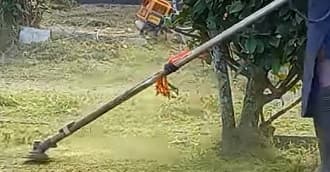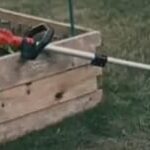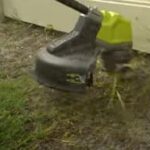As an Amazon Associate, this site earns commissions from qualifying purchases. For more information click here.
Summer is the best time to do some lawn maintenance, but the risk of fire is also at its highest. Before you put that weed eater to work, you should take all steps necessary to avoid fires. Weed eaters or string trimmers can cause a wildfire, but with the right approach you can avoid this.
A weed eater can start a fire if its metal blade makes contact with rocks and produces sparks. To avoid this, use plastic lines instead of blades. Make sure also the spark arrestor is clear, and do not use weed eaters when the temperature is too high.
Important: always wear personal protective equipment before using a weed eater. A long sleeve shirt, long pants, shoes or boots, gloves, goggles or a face shield.
How to Prevent Weed Eater Fires
Have a fire extinguisher close by as you work. The Fire Alert Home2Pro is our recommendation. The focus of this article is on string trimmer fire prevention. But if a fire does break out, you should have the means to put it out or minimize the damage. Keep your phone handy so you can call the fire department if the flames get out of control.
First, follow all the safety instructions in the owner’s manual. They are not all related to fire prevention, but will keep the trimmer in good condition. And a well-maintained string trimmer is less prone to starting fires.
Second, clear the work area as much as you can. Remove as much of the rocks and other objects so the trimmer only touches grass and weeds.
This is going to take more time but it minimizes the risk of sparks especially if you are using a bladed trimmer. By clearing the area, you ensure the trimmer is not going to hit rough or hard surfaces by accident.
Clear the Spark Arrestor
The spark arrestor is designed to prevent engine fires. For this to work, the arrestor must be cleared from any debris.
Check the spark arrestor for clogging before using it, and clear it when you are done trimming for the day. It is better to clear the arrestor regularly than wait for the debris to pile up. If the arrestor is blocked it might not function properly.
While you clear the spark arrestor, it is a good idea to inspect the rest of the engine, the fuel tank, fuel line, air and fuel filters. The spark arrestor is the most closely related to fire prevention. But maintenance is essential to avoid other problems.
Make it a habit to check the weed eater before and after use. Clean it and look for cracks, leaks or other defects. Pay attention to the engine sound. That will be your first clue if something is amiss.
Use the Right Fuel
A 2-stroke weed eater often uses a 40:1 or 50:1 mix ratio. That is, 40 or 50 parts gas for every 1 part oil. Some string trimmers use 32:1, so check your owner’s manual to be sure.
Most trimmers accept regular unleaded gas and an 87 octane rating. A higher rating is fine but anything less than 87 is not good.
Do not use the trimmer anywhere near flammable materials. Once the fuel tank is filled, move the container several feet away from the work area.
Replace fuel every 30 days. If you leave old fuel in the tank, it turns into a sticky mass that clogs the engine. The blockage limits the amount of fuel that goes into the system. This forces the engine to work harder and becomes prone to overheating.

Use Plastic Lines Instead of Blades
Use plastic strings or lines because they are not susceptible to fire like metal blades. A blade trimmer can ignite sparks if it brushes against rocks. Those sparks can burst into flames if the temperature is hot enough.
String trimmers use a nylon, plastic string to cut weeds, vegetation, grass and other materials. When you turn the trimmer on, the hub turns and causes the line to stiffen. The stiffer and thicker the line, the more weeds it can cut.
Blade trimmers are more powerful. They can cut through saplings, tall grass and thick weeds. But the blades do pose a potential fire hazard. For most landscaping and yard work, nylon strings will be fine.
Avoid Trimming During Peak Heat Hours
Do not use a weed eater when the temperature is too high. Hot weather coupled with an overheated engine is a recipe for disaster.
During summer, do not use a gas string trimmer from 11:00 AM to 6:00 PM. The peak sun hours varies so adjust the time depending on your location.
The rule is simple: if it is too hot outside to do any work, do not use a gas string trimmer. In fact do not use any gas-powered garden tool.
Wait for the temperature to cool down. Gas-powered trimmers always get hot, but the engine can overheat if the temperature soars. As much as possible, use the trimmer during early morning or late afternoon.
By waiting for the heat to dissipate, you reduce the risk of fire. Second, you are doing yourself a favor. Wearing long sleeves, face shield and other PPE during a hot day can be difficult.
Do Not Overwork the Trimmer
Weed eaters are designed for mostly dry vegetation, though you can add attachments to increase its functionality. Do not use the trimmer for something it is not designed for. That will stress the engine and could cause overheating or fire.
Gas powered weed eaters are more powerful than electric or cordless trimmers. Not all gas trimmers are the same though, as some are more powerful than others. If you have a string trimmer for instance, do not use it to cut tall grass or saplings, as those are better suited for bladed trimmers.
If you want to use your string trimmer as an edger for example, you can plug a TrimmerPlus attachment to it, provided the trimmer is compatible.
Overworking a weed eater (especially during summer) can be dangerous. That puts a lot of load on the machine that is already working at a high temperature.
Can an overheated weed eater engine cause fires? The chances of the engine blowing up is low, unless you really overwork the trimmer. But why take that risk?
Electric Weed Eater Fire Safety
The best way to avoid this is to use the trimmer as it should and let the engine cool down. An overheated engine can cause other problems like stalling when you pull the trigger.
Electric weed eaters have become more popular because of their low cost. Unlike gas weed eaters, electric trimmers will keep running as long as it is plugged to a power source.
Just like gas weed eaters, electric string trimmers can be a fire hazard. These tips can reduce the risks.
- Make certain the electric cord is not frayed. Check the connection before turning the trimmer on. It has to be plugged in securely to the power source.
- Take care not to step over the cord as you work. The cord must be long enough so you can work without pulling it out of the power outlet. It is a good idea to measure the cord first so you can determine if you need an extension or not.
- Do not use electric weed trimmers when it rains. Do not let the cord anywhere near water.
- Replace the cord immediately if there signs of fraying or tears.
Weed Eater Fire Safety Tips After Use
Allow the engine to cool off. Do not shut it off immediately. When you are done working, let the engine idle for a minute or two. When the engine has cooled, that is when you should turn it off.
Clean the trimmer after each use. Remove any dirt, debris, weeds or other stuff that is clogging the trimmer head.
Store the trimmer in a safe place. Empty the fuel tank if you won’t be using the trimmer for several weeks Or put fuel stabilizer to prevent the gas from turning into sludge.

I love the outdoors and all the tools for maintaining gardens, yards and lawns. The only thing I am more passionate about is sharing what I know about garden and outdoor equipment.


